Brazil is a continental-sized country with a rich culture and nature. Because of its climate diversity, it is a place with lots of exotic fruits, most of them which you have never heard about. I put in this table down below the 20 Most Underrated Brazilian Fruits you should try if you come to Brazil:
20 Brazilian Fruits You Should Try
| 20 Underrated Brazilian Fruits You Should Try | Name in Portuguese | Pronounce in Portuguese |
|---|---|---|
| 1. Soursop | Graviola | graavih-ola |
| 2. Cupuassu | Cupuaçú | Ku-poo-assu |
| 3. Passion Fruit | Maracujá | mah-rah-ku-shah |
| 4. Acai | Açaí | Assa-ee |
| 5. Acerola Cherry | Acerola | Asse-rolah |
| 6. Pitomba | Pitomba | Phi-thom-bah |
| 7. Caja | Cajá | Ka-jaa |
| 8. Araticum | Araticum | Ah-rah-tee-cum |
| 9. Jabuticaba | Jabuticaba | sha-booti-kaba |
| 10. Umbu | Umbu | Om-boo |
| 11. Pitanga | Pitanga | Pith-ahn-gah |
| 12. Sineguela | Siriguela | See-ree-gueh-la |
| 13. Mangaba | Mangaba | Man-gabah |
| 14. Ice Cream Bean | Ingá | In-gah |
| 15. Cashew | Caju | Ka-joo |
| 16. Guarana | Guaraná | Ghuara-nah |
| 17. Brazil nut | Castanha do Pará | Kas-tanya |
| 18. Pineapple | Abacaxi | Ah-bah-ka-shee |
| 19. Guava | Goiaba | Goy-ah-bah |
| 20. Star fruit | Carambola | Ka-rahn-bolah |
My name is Claudio Pereira, I am a Brazilian photographer, and I will show you here everything you need to know about the Brazilian fruits. I explain in this post the fruits’ flavors, where to find them, how to eat them, its benefits for your health, and how to pronounce their names in Brazilian Portuguese. Enjoy it!
1. Soursop (Portuguese = Graviola)
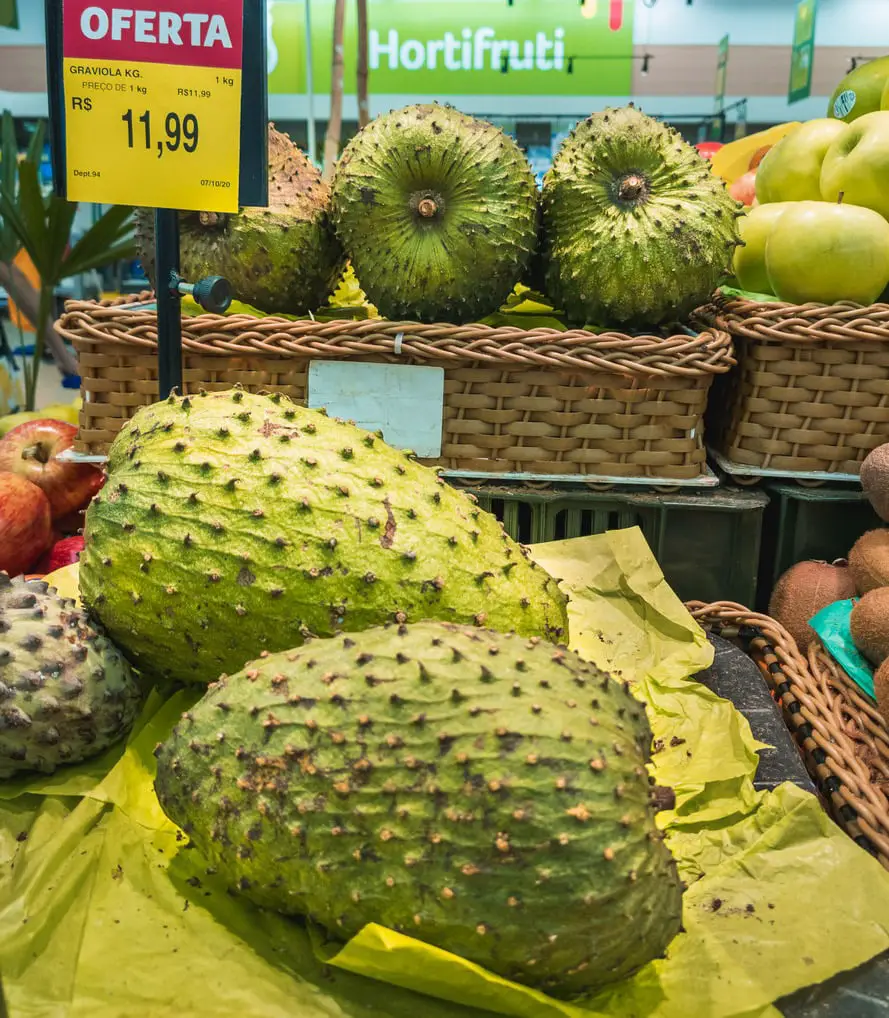
The Soursop is a slightly sweet and slightly acidic fruit. Its taste is unique and very appreciated in Brazil, and because of that, It’s a very popular fruit to make juice and recipes. The soursop isn’t as cheap as bananas in Brazil, but it is worth it to eat and drink its juice.
It is hard to find the fruit in the Brazilian supermarkets, but most of them sell the pulp soursop juice. This fruit has anti-inflammatory and antioxidant effects, which works as an anti-aging, and also improves your immunity because of its vitamin C presence.
To pronounce its name in Portuguese, say: graavih-ola.
2. Cupuassu (Portuguese = Cupuaçú)
Cupuassu juice is my favorite one! Most Brazilians like it, and I think you’ll like it too.
You will not find this fruit in the supermarket, but such as soursop, the pulp cupuassu juice is sold everywhere. It’s good to make desserts and juice, and it is a slightly acidic fruit, with an indescribable taste.
The Cupuassu is rich in vitamin C, which helps the immunity system, in fibers, that improve your intestine work, and it has some therapeutic effects for the skin, helping to keep it strong and healthy.
To pronounce its name in Portuguese, say: Ku-poo-assu.
3. Passion Fruit (Portuguese = Maracujá)
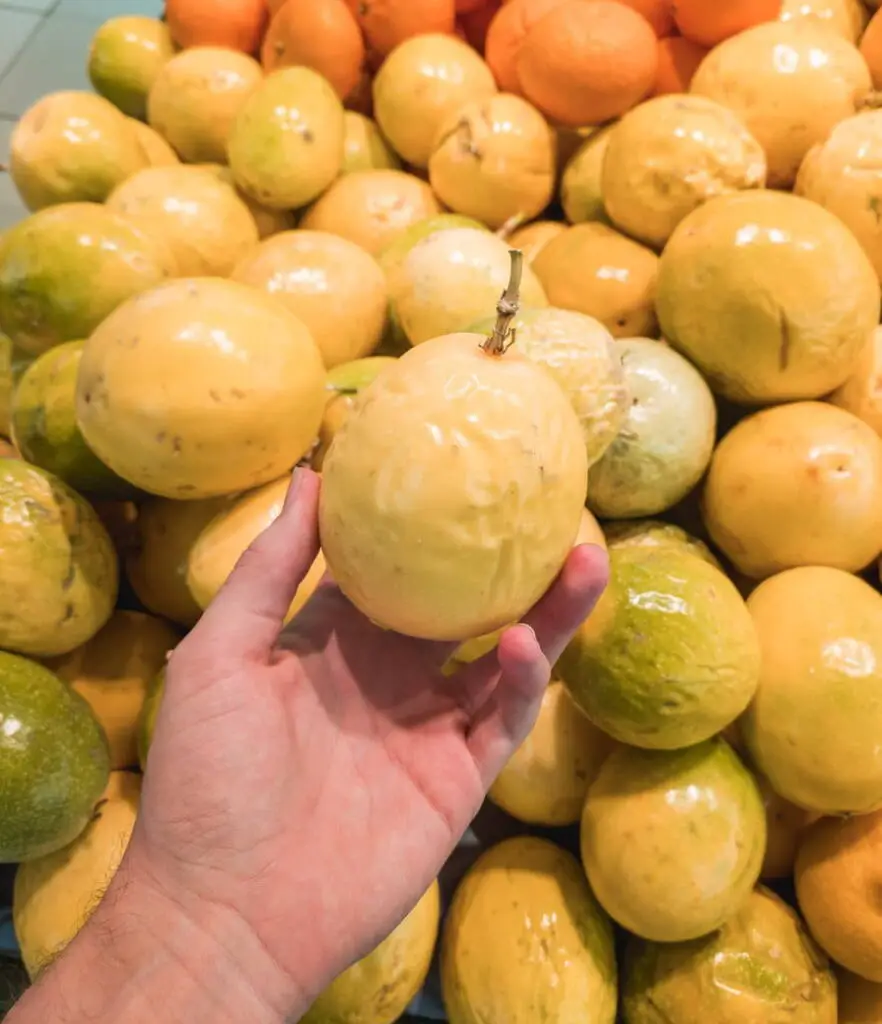
This is one of the most famous Brazilian fruits. You can find it in supermarkets in all the Brazilian states. This fruit isn’t good to eat, because it is acidic such as lemon. Yet, it is outstanding to produce juices, sweet syrups, and desserts. The desserts made with passion fruit are some of my favorite ones, and you should try if you come to Brazil.
The passion fruit also works as a natural calming and has a lot of vitamin C, which improves your immunity defenses.
Here is the Pronunciation spelling for you to say the fruit’s name in Portuguese: mah-rah-ku-shah.
4. Acai (Portuguese = Açaí)
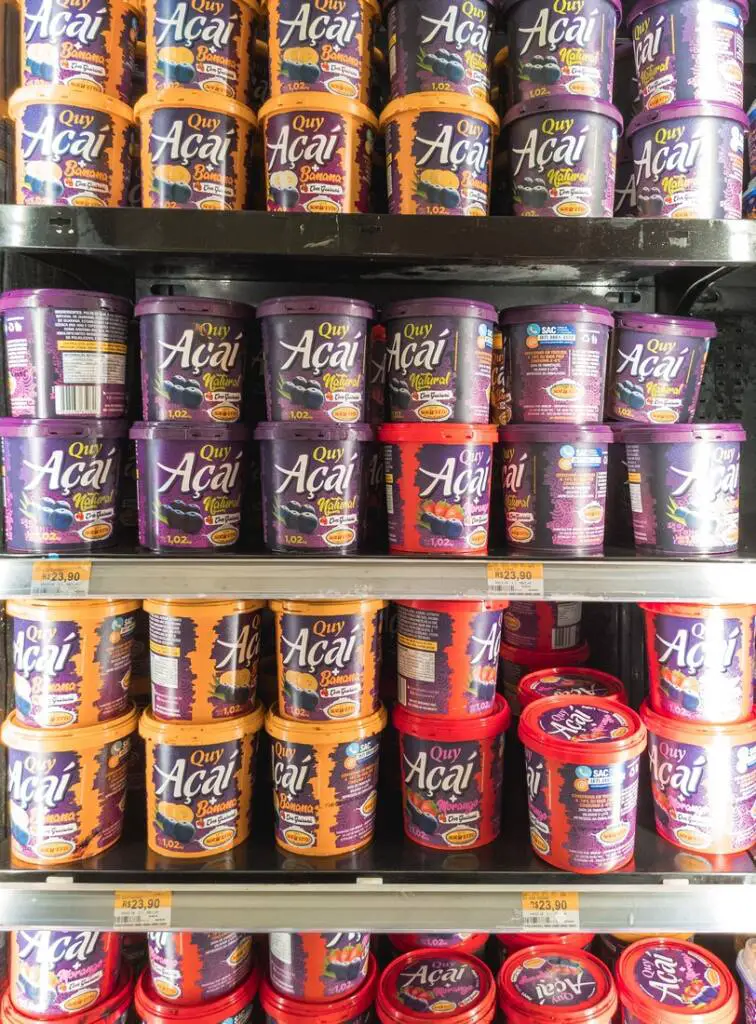
Acai is another world-famous Brazilian fruit. It’s a sweet berry with a special taste, which is consumed in juices, frozen, and many more. It’s natural from Amazon, but the Acai frozen is popular in other parts of Brazil and the world. Because of that, today it’s produced in places other than Amazon, even in different countries.
You won’t find Acai berry in most of the Brazilian supermarkets, but you can easily find the pulp Acai juice and the Acai frozen.
Acai has antioxidant effects, which are good to prevent skin aging. It is also rich in anthocyanins and polyphenols, which improves cardiovascular function and helps to prevent cardiac diseases.
To pronounce its name in Portuguese, say: Assa-ee.
5. Acerola cherry (Portuguese = Acerola)
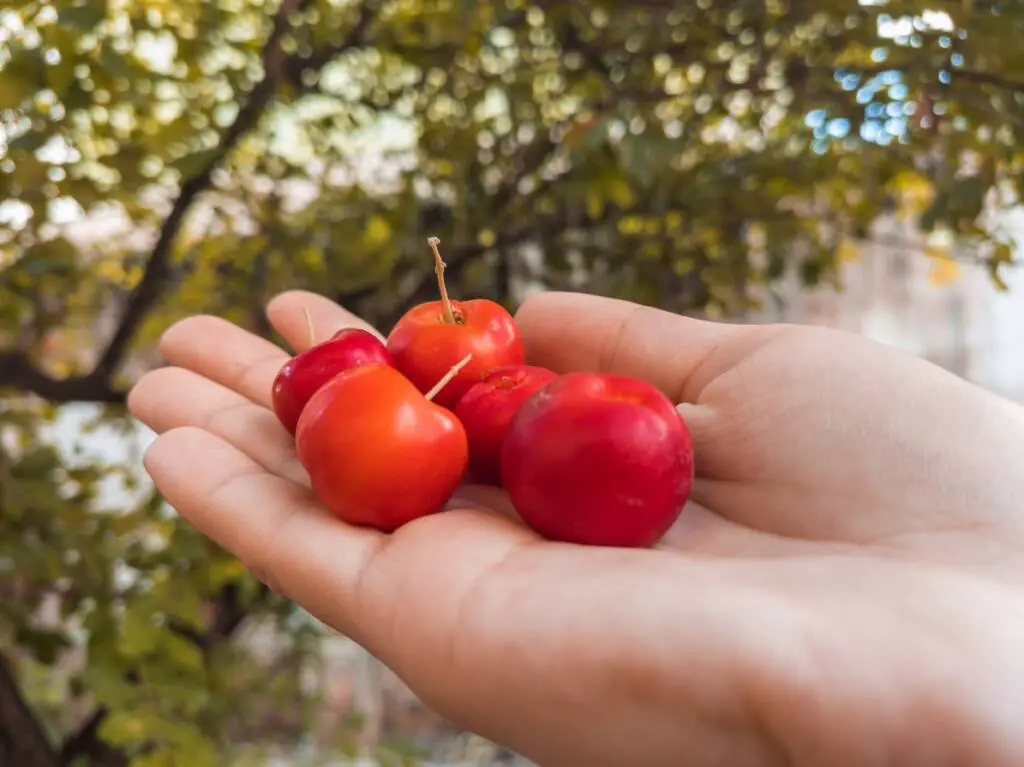
The Acerola cherry was introduced in Brazil in 1955 by the Rural Federal University of Pernambuco. The population liked it and planted it in other cities and states, which made the fruit widely appreciated throughout the country.
The fruit is sweet and acidic. You can eat the acerola raw or use it in juices and recipes. It’s easy to find it in some houses’ backyards and gardens, but it’s not common to buy this fruit in the supermarket. The pulp Acerola juice is largely sold in lots of supermarkets.
The acerola is rich in vitamins A and C and has 40 times more vitamin C than an orange. These vitamins work as antioxidants and improve the immunity system. The fruit also helps to keep the skin healthy.
To pronounce its name in Portuguese, say: Asse-rolah.
6. Pitomba (Portuguese = Pitomba)
This is another of my top 3 Brazilian fruits. Pitomba has a sweet flavor and a peculiar way to eat it. First, to eat this fruit, you need to peel with your fingers, then nibble or suck the flesh from the seed. This process is like eating lychee, and its taste is similar, but the pitomba is sweeter.
You will not find this fruit in supermarkets, but you can buy it in some outdoor markets in the Brazilian Northeast and North (Amazon). Pitomba is eaten raw, and it is not used to make juice typically.
Pitomba is rich in Iron and Calcium, helping you to prevent anemia and osteoporosis. It also contains vitamin C, which improves your immunity.
To pronounce its name in Portuguese, say: Phi-thom-bah.
7. Caja (Portuguese = Cajá)
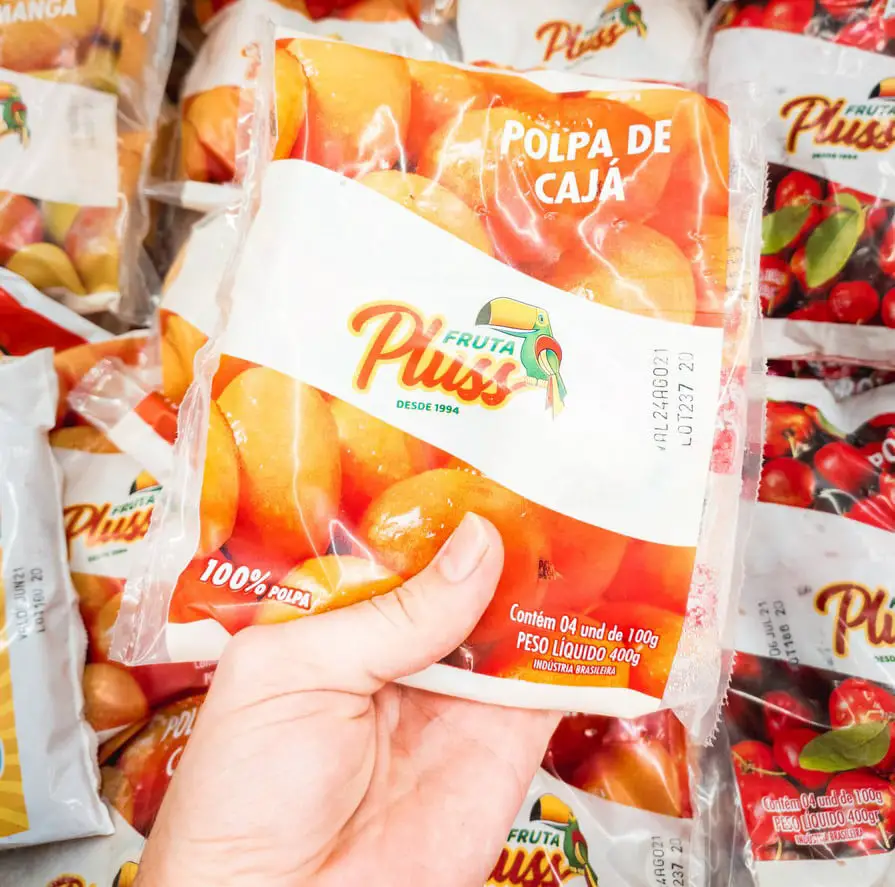
Caja is a delicious bittersweet and slightly acidic fruit from Brazil. It’s mostly found in the Brazilian Northeast, Amazon, and São Paulo. You can eat the caja raw, or use it to make juices, cocktails, desserts, and many more.
You can buy Caja in some Outdoor markets and supermarkets, especially in the Brazilian Northeast. However, it is easier to find the pulp Caja juice in the supermarkets, which is cheap and as nutritious as the fruit. If you also want to know the overall price of food and the cost of living in Brazil, I have this post here.
The Caja has many beneficial effects on the body: it helps to lose weight because it has few calories, has vitamin A, which improves the eye vision, and it also helps in heart health, because of its antioxidant effects.
To pronounce its name in Portuguese, say: Ka-jaa.
8. Araticum (Portuguese = Araticum)
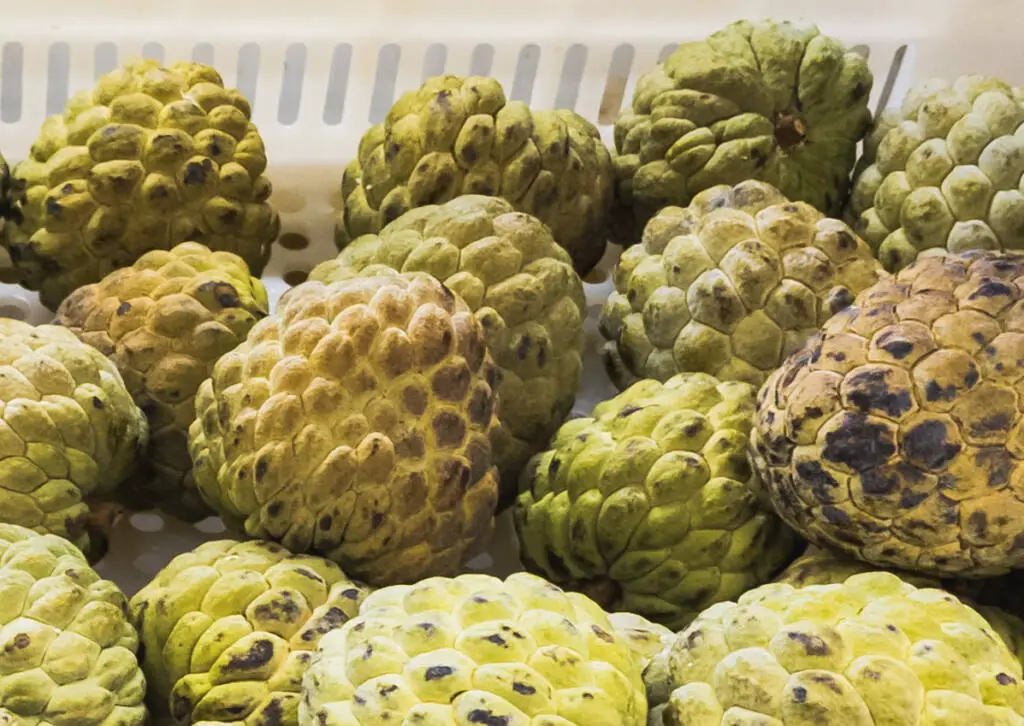
The Araticun is a fruit from the same family as the sugar apple, which is found in the Brazilian Midwest. This is a sweet fruit with a striking savor, which is eaten raw or used to make cookies, jellies, juices, liquors, cakes, ice cream, and desserts.
You can sometimes find this fruit in the supermarket, however, it is usually most find in outdoor markets, especially in the Brazilian Midwest or Northeast.
Araticum is rich in antioxidants, preventing aging and degenerative diseases. It also has iron, potassium, calcium, vitamins C, A, B1, and B2.
Because of that, it prevents anemia and osteoporosis, helps the cardiac health and the immune system, and prevents neurological diseases.
To pronounce its name in Portuguese, say: Ah-rah-tee-cum.
9. Jabuticaba (Portuguese = Jabuticaba)
Jabuticaba is a sweet fruit, which is common in The Atlantic Forest. This fruit, differently from the Other fruits, grows directly in the tree stem, which gives a peculiar appearance to the Jabuticaba trees. The Jabuticaba Can be eaten raw or you can use it to make juice, jam, and ice cream.
You can find Jabuticaba in some outdoor markets or you can buy the pulp jabuticaba juice in the supermarkets.
The Jabuticaba peel is rich in antioxidants, which prevent aging, and also has anthocyanins, that acts as an anti-inflammatory, reducing pain. The fruit is also rich in Iron, Magnesium, phosphorus, fibers, vitamins C, B1, and B2.
To pronounce its name in Portuguese, say: sha-booti-kaba.
10. Umbu (Portuguese = Umbu)
Umbu is another typical fruit from the Brazilian Northeast. This Brazilian fruit is natural from the northeastern hinterland (Sertão), and you will not find it on the Brazilian coast. If you visit it, eat this fruit, because it has a unique taste and it’s also part of the culture of this region.
The Umbu is a sweet and slightly acidic fruit, which is usually eaten raw, but it’s also used in many recipes, jam, juices, and desserts. It’s only found on the outdoor markets of the northeast hinterland, but if you’re lucky, you may find a pulp umbu juice in the supermarket.
Umbu is rich in vitamins A, B, and C, and improves the immunological system. It also helps to lose weight and to eliminate intestinal gas.
To pronounce its name in Portuguese, say: Om-boo.
11. Pitanga (Portuguese = Pitanga)
Pitanga is a citrus fruit with an acidic and slightly sweet taste, which grows in the Atlantic Forest area, which includes the Northeast, the Southeast, and the South of Brazil. It’s eaten raw or used to make juices and recipes.
You won’t find it in the supermarket either in outdoor markets, because it’s easily damaged during transportation when it is ripe. Yet, you can buy pulp pitanga juice in many supermarkets. However, it’s common to find it in some people’s gardens or on some street trees.
The pitanga is a low-carb fruit, which helps you to lose weight. It is rich in vitamins A, C, and B, improving the immune system, eye vision, and hair health. Pitanga also has a significant amount of calcium, iron, and phosphorus, preventing osteoporosis, anemia, and improving heart function, respectively.
To pronounce its name in Portuguese, say: Pith-ahn-gah.
12. Sineguela (Portuguese = Siriguela)
The Sineguela is a special and underrated Brazilian fruit. It is a savory fruit with a perfect balance between acidic and sweet flavors, and it’s mostly found in the Brazilian Northeast, such as Umbu, Pitomba, and Pitanga. The Brazilian people eat this fruit raw or use it to make juices and desserts. This Brazilian fruit is widely sold in outdoor markets, however, it is not found in supermarkets commonly.
The sineguela has many benefits, and it helps to satiate because it’s rich in fibers, and also gives the energy to practice exercises. It also prevents aging and improves the immune system, because of the vitamin C it has in its composition.
To pronounce its name in Portuguese, say: See-ree-gueh-la.
13. Mangaba (Portuguese = Mangaba)
Mangaba is another famous Brazilian fruit, which has a sweet and acidic taste. This is one of the most delicious fruits from Brazil, and you can use it in many ways. You can eat the mangaba raw or use it to make desserts, jams, juices, and many more.
Mangaba is found in some supermarkets, especially in the Brazilian Northeast and Southeast. You can also find its pulp juice or desserts selling in the markets.
The mangaba is rich in Vitamins A and C, B1, B2, which are antioxidants and helps to improve the vision and immunological system, and iron, phosphorus, calcium, and fibers. The mangaba leaf tea also helps to decrease blood pressure, and its properties are being studied by some universities.
However, you should never eat the mangaba when it is unripe because it can contain some toxic components inside. If you eat it ripe, it’s ok, and the toxin is gone.
To pronounce its name in Portuguese, say: Man-gabah.
14. Ice Cream Bean (Portuguese = Ingá)
The Ice Cream Bean is another peculiar fruit from Brazil. The fruit looks like a giant bean pod, and when you open it, you find the sweet pulp. It has a sweet and astringent taste, and it is eaten raw or used to make ice cream and mousse.
You can find this fruit in the Brazilian Northeast and North (Amazon). You will not find it in the supermarket, neither in outdoor markets, but you can find it in some street trees.
The Ice Cream Bean is rich in calcium, preventing osteoporosis, and helps to reduce the headache. It also helps to improve the immune system and has antioxidants, which has some therapeutic effects for the skin, preventing aging.
To pronounce its name in Portuguese, say: In-gah.
15. Cashew (Portuguese = Caju)
This is a Brazilian natural fruit, which was exported centuries ago to Asia and Africa. After that, it becomes a widely consumed fruit in different countries. It’s a sweet fruit with an astringent taste, and you can eat it or consume the cashew pulp in juices, desserts, and recipes. If you toast the cashew seed, you have the cashew nut, which is used in many recipes and can also make butter.
You can find cashews in many Brazilian outdoor markets, and pulp cashew juice in supermarkets.
The cashew has five times more vitamin C than the Orange and Zinc, which improve your immunity system. It is also rich in Calcium and Iron, which help your bones and prevent anemia, respectively. The cashew nut is rich in unsaturated fat and helps to reduce cholesterol levels.
To pronounce its name in Portuguese, say: Ka-joo.
16. Guarana (Portuguese = Guaraná)
Guarana is a Brazilian fruit from Amazon. It’s mostly used to make juices and sodas. You will not find it in the supermarket, but you can easily find the pulp guarana juice. This Brazilian fruit is also sold as a powder, which is used to make juices.
There is also a famous soda in Brazil made with Guaraná, which is named “Guaraná Antarctica”. This soda is cheap and you can buy it everywhere.
Guarana improves mood, alertness, and delays fatigue, and, because of that, its juice is commonly drunk before and after going to the gym. It also helps to reduce cholesterol and triglycerides.
To pronounce its name in Portuguese, say: Ghuara-nah.
17. Brazil nut (Portuguese = Castanha do Pará)
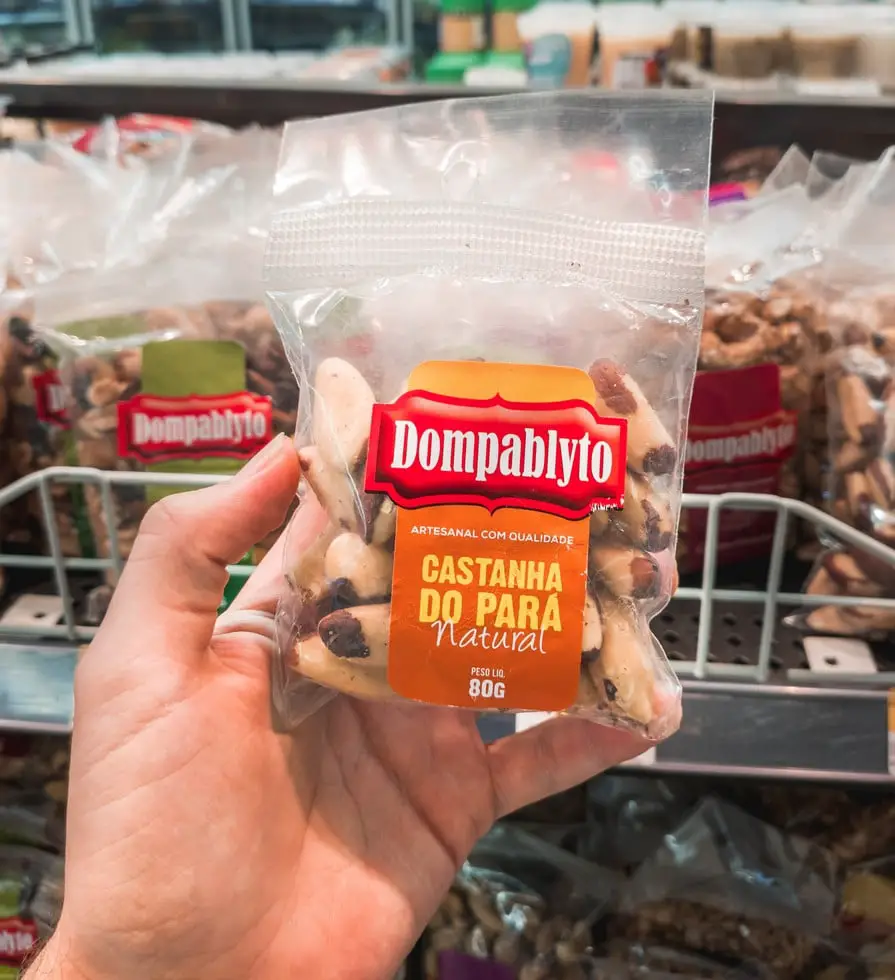
The Brazil nut is a tree seed from the Amazon, which grows naturally in the North of Brazil and Bolivia. This seed is popular to make granola, and it’s widely consumed for its characteristic taste and nutritional properties. You can find it in most health food stores and some supermarkets.
The Brazil Nut is rich in vitamin E, selenium, and omega-9. It helps in heart health and works to prevent thrombosis and Alzheimer’s disease. However, because it has an extensive amount of selenium inside, it is healthier to eat one or two per day at maximum.
To pronounce its name in Portuguese, say: Kas-tanya.
18. Pineapple (Portuguese = Abacaxi)
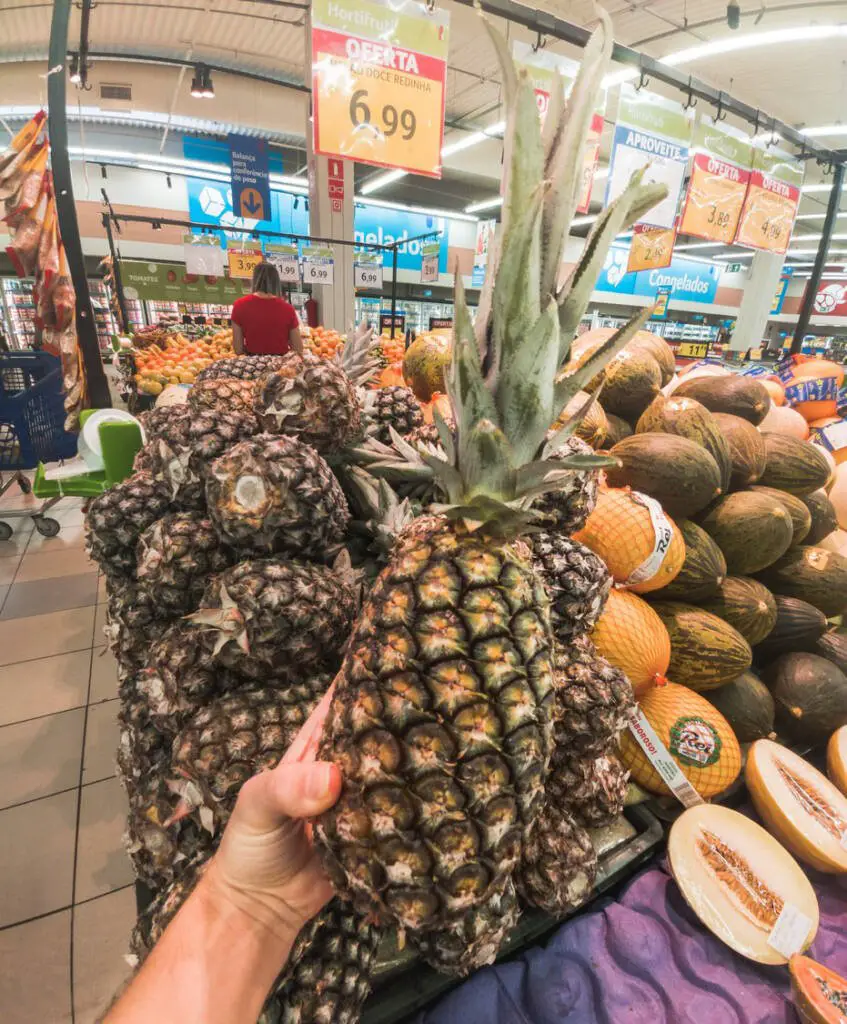
This is a world-famous fruit that naturally grows in Brazil. Pineapple is a citrus and sweetie fruit, widely produced in other countries today. You can find Pineapples in all Brazilian supermarkets, and it’s a cheap and popular fruit in Brazil. Brazilian people use pineapple to make juices, desserts, cakes, and many more.
The pineapple also is rich in vitamins A and C, which are antioxidants that improve the immunity system and vision. It also works as an anti-inflammatory and reduces the risk of thrombosis.
To pronounce its name in Portuguese, say: Ah-bah-ka-shee.
19. Guava (Portuguese = Goiaba)
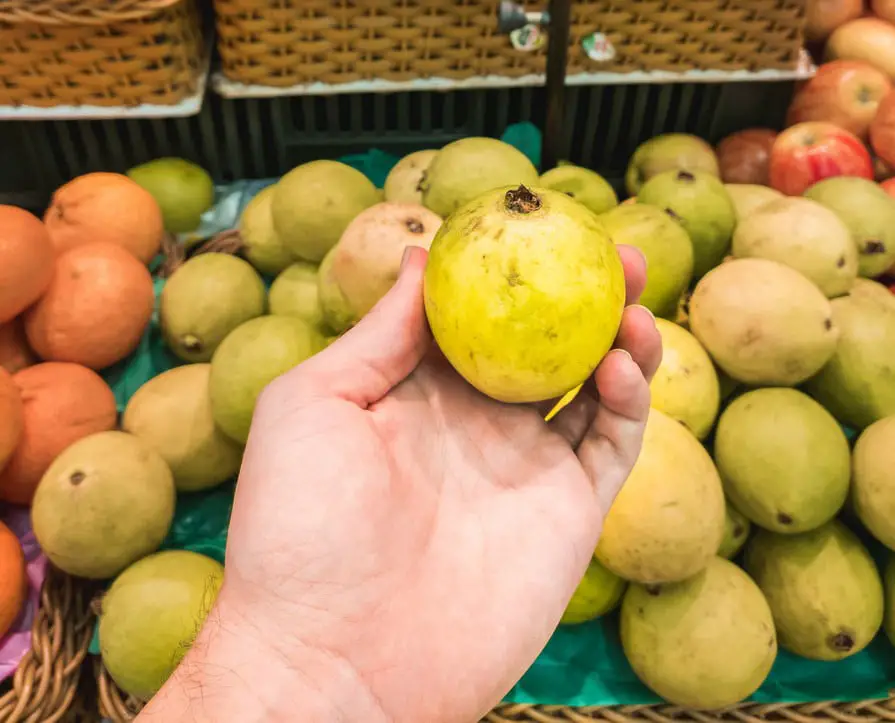
Guava is one of the most appreciated fruits by people from all over the world today. It’s also largely consumed in Brazil, especially in juices and desserts, such as the popular “Goiabada”.
This fruit has a sweet taste, and the best tastes are from the ones you take ripe straight from the tree. The guava trees grow naturally in the Atlantic Forest area, which is on the Brazilian coast from the Northeast to the South.
The Guava is rich in fibers, Potassium, Vitamins A and C, Lycopene, and helps to reduce the LDL cholesterol levels. Vitamin C and Lycopene also work as antioxidants, reducing skin aging.
To pronounce its name in Portuguese, say: Goy-ah-bah.
20. Star fruit (Portuguese = Carambola)
Star fruit is a sweet fruit common in the Brazilian Northeast, but you can find it in some supermarkets and Outdoor Markets from the Southeast and South of Brazil too. It’s natural from India, and it was introduced in Brazil some centuries ago, being used as an ornamental plant at first. The star fruit is popular in Brazil, and the people usually consume it raw.
The Star fruit is rich in fibers and vitamin C. It also helps to reduce the formation of fat cells and works as an anti-inflammatory, reducing the pain.
If you have kidney diseases, it is better to avoid this fruit, because it has a substance named “caramboxin”, which can damage your kidney. In healthy people, it is not dangerous, because our bodies can excrete it properly. However, don’t exaggerate eating it or drinking its juice.
To pronounce its name in Portuguese, say: Ka-rahn-bolah.
Other fruits you can find in Brazil
There are other fruits you can find in the Brazilian supermarkets and outdoor markets, which are natural from other countries but widely consumed here in Brazil.
This table below has the name of these fruits in English, in Brazilian Portuguese, and how to pronounce it in Portuguese.
| Name | Name in Portuguese | Pronounce in Portuguese |
|---|---|---|
| Grape | Uva | Oo-vah |
| Avocado | Abacate | ahbah-cahti |
| Apple | Maçã | Mah-sun |
| Lemon | Limão | Li-moum |
| Coconut | Coco | Coco |
| Orange | Laranja | lah-ran-jaa |
| Tangerine | Tangerina | Thum-jee-ri-naa |
| Banana | Banana | Ba-na-na |
| Strawberry | Morango | Mor-an-go |
| Papaya | Mamão | Ma-maum |
| Mango | Manga | Man-gah |
| Jackfruit | Jaca | jaa-ka |
| Watermelon | Melancia | Mel-an-ci-ah |
| Melon | Melão | Mel-om |
| Pear | Pera | Pe-ra |
| Plum | Ameixa | A-mei-sha |
| Peach | Pêssego | Pe-se-go |
| Fig | Figo | Fee-go |
| Sugar Apple | Pinha | Pee-nya |
And that’s it, guys. I hope you had enjoyed the post!
Have you ever tried any of the Brazilian fruits? Which one is your favorite? Share with us in the comments!
Also, if you have some questions, ask me in the comment section down below, and I’ll respond to you as soon as possible.
Everything You Need To Know About The Brazilian Fruits Brazil is a continental-sized country with a rich culture and nature. Because of its climate diversity,…
The Complete Guide for Cruise Ship Tourists in Recife Port The Recife New Marine terminal was opened in 2014. Since then, lots of cruise ships…
If you’ll travel to Brazil, it’s important to know about the Brazilian etiquette rules. Here, I have 12 thinks you should never do in Brazil….

Claudio Pereira
Author
He is a brazilian writing in english, a student of Medical School, and a Photographer during the free time. His passion for photography started in 2012 , and after discover it, he never stopped.
